The best hunting dogs come from a range of breeds, all with one goal: to help support your hunting endeavors.
Hunting dogs are excellent at picking up game scents, tracking, treeing, retrieving, or bringing down big game.
Depending on whether you hunt wildfowl, small game, or big boys, these are the best dog breeds to consider for your trips.
13 Best Dogs for Hunting
Pick a dog breed that matches your hunting requirements and is also a valuable home companion. Here is our list:
1. Beagles
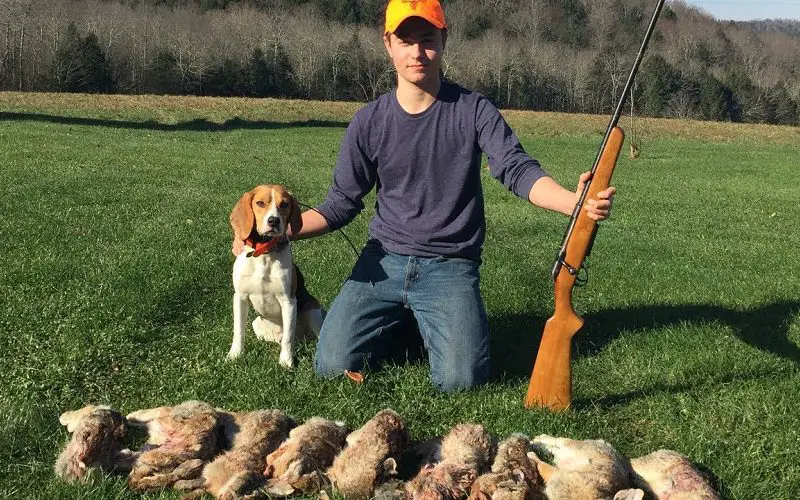
Beagles date back to Greek times, around 400 B.C., when they used a similar animal to help them hunt.
Fast-forward to the early 1880s in the United Kingdom, when breeders mixed the Southern Hound, the Talbot Hound, and the North Country Beagle to give us the current version of this breed.
The modern beagle may also include the Harrier. Beagles are relatively small dogs with a life expectancy of around 12 to 15 years and an average weight of 17 to 33 pounds.
They were bred as hunting dogs, moving away from the beagles’ background. With an excellent nose, these dogs are excellent hunters.
Their owners explicitly raised beagles to help them take down rabbits, but they also make excellent helpers when chasing down other small prey, like wild pigs and jackals.
Loyal and hard-working to the core, this breed also makes a beautiful family pet.
2. Bluetick Coonhound
The Bluetick Coonhound is a U.S. creation, dating back to colonial times. Initially bred with the English Foxhound and the French Staghound (Grand Bleu de Gascogne), among several others in Louisiana, the Bluetick Coonhound is a large dog breed.
Old-fashioned blueticks are well-muscled and weigh an average of 45 to 80 pounds. This breed’s life expectancy averages around 11 to 12 years.
Known to be fearless, the bluetick is one of the best hunting dogs for big game. When tracking cougars and other large prey, take them with you because you’ll need a fearless assistant by your side.
You can also trust the bluetick to trap prey in a tree and bark its head off with excitement while waiting for you to catch up and finish the job.
3. Labrador Retriever
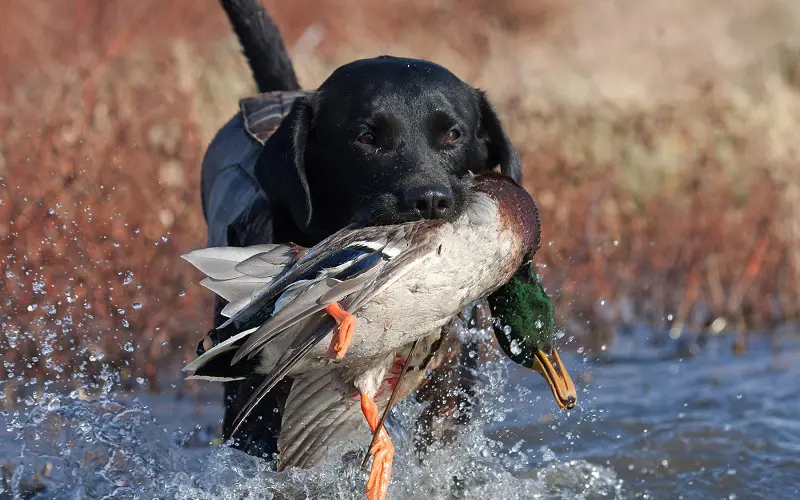
It is believed that Labrador Retrievers, or Labs, as they are more commonly known, originated in the early 1830s.
Newfoundland’s European settlers first sent this breed over to Britain as part of the trading activities between Canada and Dorsetshire. The Brits then combined this import with local hunting dogs to create the modern Lab.
Labradors generally live for around 10 to 12 years, and their weight averages between 55 and 78 pounds.
This breed’s hunting prowess is focused on duck hunting and retrieval. Able to endure the cold northern climates and being great water lovers, the Brits used these characteristics to their advantage as great hunters themselves.
Like many other dog breeds, the Lab is exceptionally loyal, enthusiastic, and non-aggressive. These dogs are excellent water retrieval specialists, as well as gun dogs. Labradors are also sought-after family pets.
4. Bloodhound
During the Middle Ages, hunting was as popular as it is today, but people hunted boar and wild deer for food as well as for sport. People in the Middle Ages used the bloodhound to hunt wild animals, just as they did for criminals.
Bloodhounds are believed to be descendants of the dogs kept by Belgian monks at the Abbey of Saint-Hubert.
This breed is known as le Chien de Saint-Hubert in French. It has a strong build, can rock the scales between 77 and 120 pounds, and lives anywhere from seven to ten years.
Bloodhounds are famous for their keen noses and being intrepid trackers. When you need help locating a game, bloodhounds are a viable option.
5. Pointers
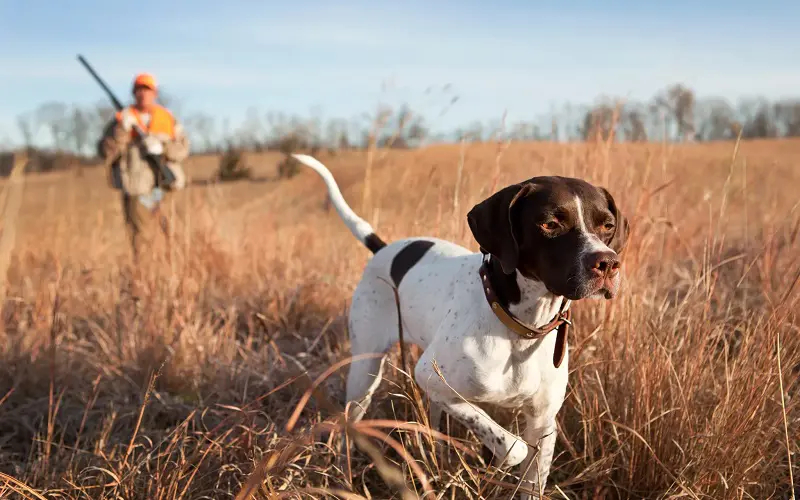
Pointers also have British origins dating as far back as 1650. British hunters first used these animals to support greyhounds by tracking hares, which the greyhounds would then catch.
Later, in the 1800s, the Brits trained Pointers to retrieve birds and be excellent gun dogs, making this breed multi-talented as hunting dogs.
Pointers have a life expectancy of 11 to 14 years and attain average weights of 50 to 73 pounds. This dog breed has a thin, short coat that enables it to endure high humidity and extreme heat.
Add voluminous amounts of stamina and loyalty, and you have one of the best hunting dogs to accompany you on your next duck hunting excursion.
6. Catahoula Leopard
The Catahoula Leopard dog, another hunting breed with U.S. origins, is the result of interbreeding native American dogs, Greyhounds, and Spanish Mastiffs.
Native Americans took this dog with them when they wanted to take down large prey. Early colonialists in Louisiana took this breed with them on hunts in local swamps, and they were valuable in protecting and herding their livestock.
The Catahoula Leopard is just as skilled at identifying trail scents to track and trap small game as they are at hunting large game.
You can take the Catahoula Leopard dog on hunts when pursuing wild boar, feral pigs, bobcats, bears, deer, or even birds.
Catahoula Leopard dogs reach weights of 50 to 90 pounds and live between 10 and 14 years.
7. American Foxhound
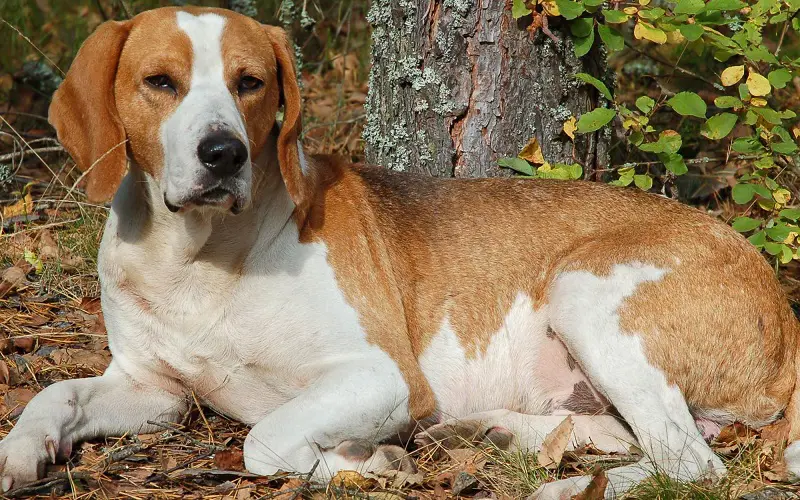
American Foxhounds date back to the mid-1600s, when Robert Brooke brought hound packs back with him from his trip to Britain.
This dog breed later became famous in Maryland and Virginia in the early part of the 1700s, and gained recognition from the American Kennel Club in 1886.
The American Foxhound was then bred into distinct types, including field trial, slow-trailing, drag, and trail hounds, each with specific skills as the best hunting dogs.
Field trial American Foxhounds are competitive and speedy. Breeders bred slow-trailing hounds to hunt foxes. Drag or trail hounds are best for hunting big game, preferably in packs.
American foxhounds are well-known for their fascinating baying while on the hunt. This breed makes an ideal, non-aggressive family pet and weighs approximately 55 to 73 pounds. These animals can live up to 11 or 13 years on average.
8. Chesapeake Bay Retriever
As the name suggests, the Chesapeake Bay retriever has its origins in the U.S. Similar to the Labrador and its British heritage, the U.S. bred the Chesapeake Bay retriever from the St. John’s Water Dogs.
Their breeding near a bay clearly demonstrates their purpose as hunting dogs. The Chesapeake Bay retriever is a top choice for hunting, and they are enthusiastic about retrieving waterfowl, so they are the ideal choice for anyone who loves duck hunting.
This breed makes excellent gun dogs and flushers, and it is easily on par with other retriever breeds in its love of water and ability to withstand cold, icy conditions.
Its coat is oily, and it has webs between its toes, ensuring that this industrious hunter is also an excellent swimmer.
The Chesapeake Bay retriever can live for 12 to 14 years and grows to weights of between 44 and 55 pounds. On duck hunts, take this gun dog to flush out your prey without missing a beat.
9. Weimaraner
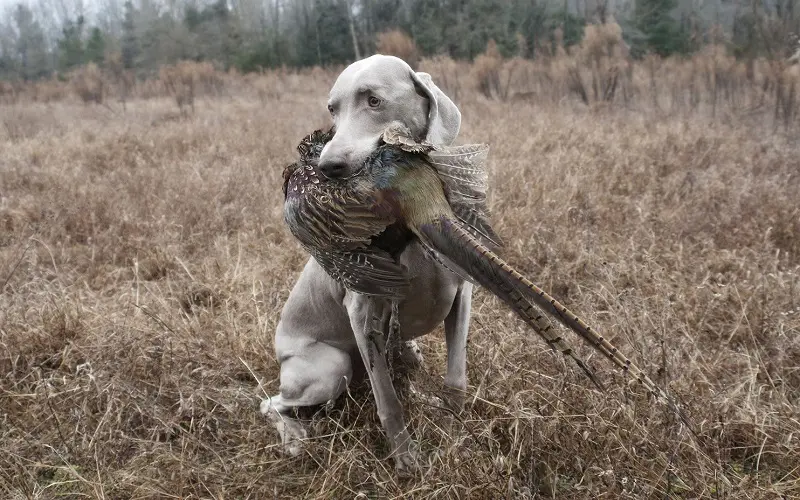
Weimar first bred the Weimaraner, a uniquely German, gray-coated hunting breed. Noblemen raised these animals to be the best hunting dogs around the late 1700s and early 1800s.
The American Kennel Club officially recognized the Weimaraner breed in 1943, and it still retains its popularity as a hunting dog and a family pet.
Weimaraners are recognizable for their skill in hunting small or large game animals like coyotes, bears, and deer.
This breed has considerable skills as the best hunting dog because it is a good gun dog and provides the perfect support when hunting upland birds such as pheasants.
Weimaraners are agile, fast, and have an excellent nose for scents. This breed will help track, trap, and retrieve prey. The Silver Ghost is the perfect companion on the hunt for prey.
Despite its elegant structure, the Weimaraner is well-muscled and reaches weights of 55 to 66 pounds. This dog breed has a lifespan of up to 13 years, so train your Weimaraner for long-term hunting exploits.
10. Norwegian Elkhound
This dog breed’s history dates back to 5000 B.C. in Norway, where people used them to hunt large game like elk.
Norwegian elkhounds were also known to be valuable working dogs as they protected livestock. Another of their duties was to pull sleighs.
Today, the Norwegian Elkhound is one of the best hunting dogs for big game, including bears, moose, and elk. Despite their relatively small stature, these animals are fearless, and they are also excellent guard animals.
Norwegian elkhounds can attain weights of 40 to 60 pounds and live up to 12 years. When you want the best hunting dogs for the big game in the U.S., the Norwegian Elkhound is full of confidence in achieving this goal while also protecting you from danger.
11. Vizsla

Vizslas are a Hungarian dog breed that is over 1,000 years old. This breed is believed to have resulted from a mixture of the Turkish yellow dog and the Transylvanian hound.
This animal was bred by Hungarian Magyars for its stealth and quickness on the hunt, as well as its readiness to alert hunters to prey in the vicinity. Initially trained to hunt hares and game birds, this breed later learned to point and retrieve.
Although the Vizsla almost went extinct in the late 1800s, breeders managed to save this animal because of its hunting characteristics.
Vizslas have a strong resemblance to the Weimaraner in size and structure, but their coats are a beautiful, burnished copper color.
Vizslas reach weights of between 55 and 60 pounds and can live up to 14 years. Although this breed is one of the best hunting dogs and a good companion, do not keep it around smaller animals like cats, rabbits, or guinea pigs, as its prey drive is well-honed.
12. English Springer Spaniel
The English Springer Spaniel has one of the oldest histories in dog breeding. The Romans are believed to have brought this dog breed to England and traced its origins to Spain and Wales in 300 A.D.
In 1913, immigrants from England brought this breed to Canada. It later found its way to the U.S., where it is now among the best dogs for hunting and family pets.
For as long as history books date back to the English Springer Spaniel’s existence, nobles and peasants alike have used this hunting dog.
Its talents include hunting small game by flushing them from their hiding places. The English Springer Spaniel has a taste for this sport, whether you’re after birds or animals.
This breed makes superior gun dogs and is the best for flushing out game, whether a cocker or a springer spaniel. The English Springer Spaniel is small, only reaching 44 to 55 pounds, and it can live between 12 and 14 years.
13. Irish Setter
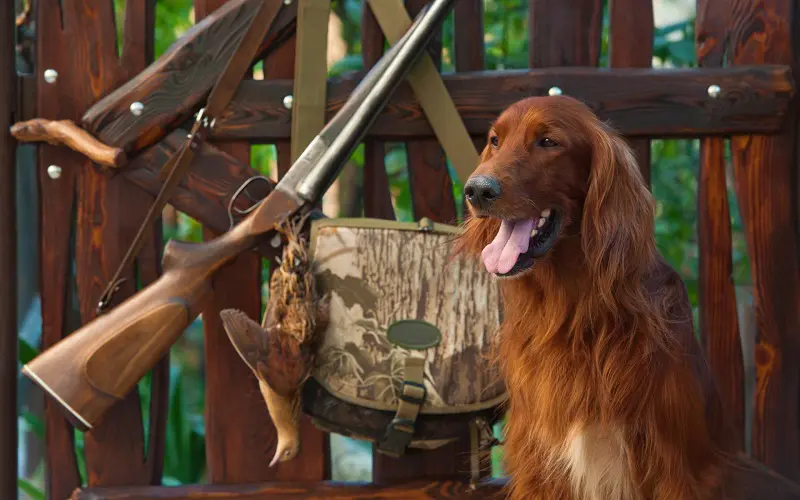
Irish Setters were popular in Ireland in the 1700s before crossing the ocean to make North America their home in the mid-1800s. Breeders believe that today’s Irish Setter, with its distinctive red coat, is the result of mixing the English Setter Spaniel and the Gordon Setter.
Although the Irish Setter appears to be a delicate dog breed, its looks are deceptive. Irish Setters are in top place, as the hunting dogs for tracking small game are Irish Setters.
These animals are also famous for being bird-trackers. Irish Setters are not only beautiful but also effective. These dogs are agile and develop a powerful intent to catch their prey when out in the field.
Irish Setters may be delicate-looking, but they are also large dogs, weighing 53 to 70 pounds. Train these animals, and you will get the best return on your investment because they have a lifespan of up to 15 years.
Wrap-Up
What’s your hunting requirement?
Do you want help with bagging big game, waterfowl, or do you have your eyes set on small game animals?
Regardless of your hunting preferences, you can find the best dogs to accompany you on the field.